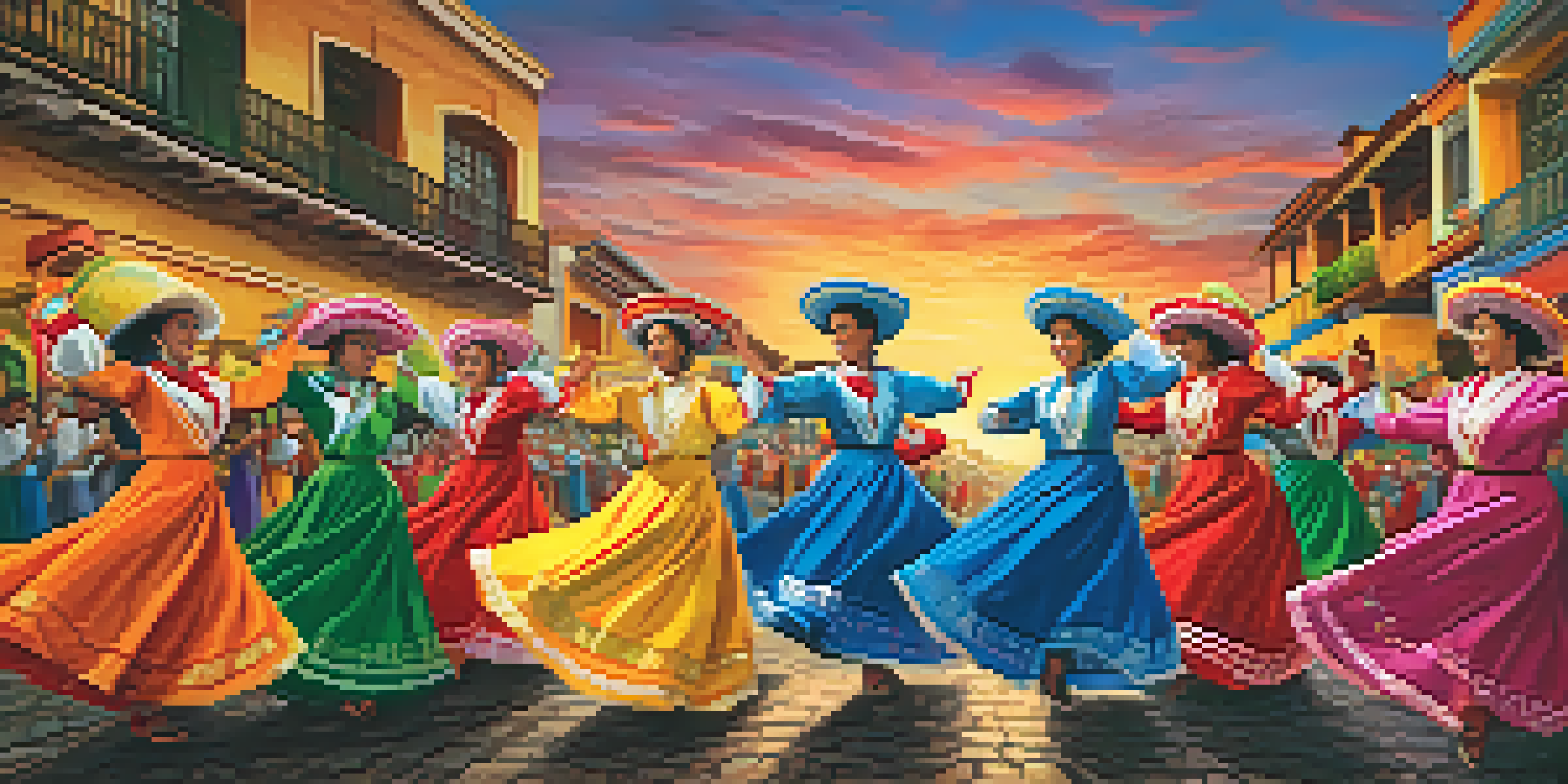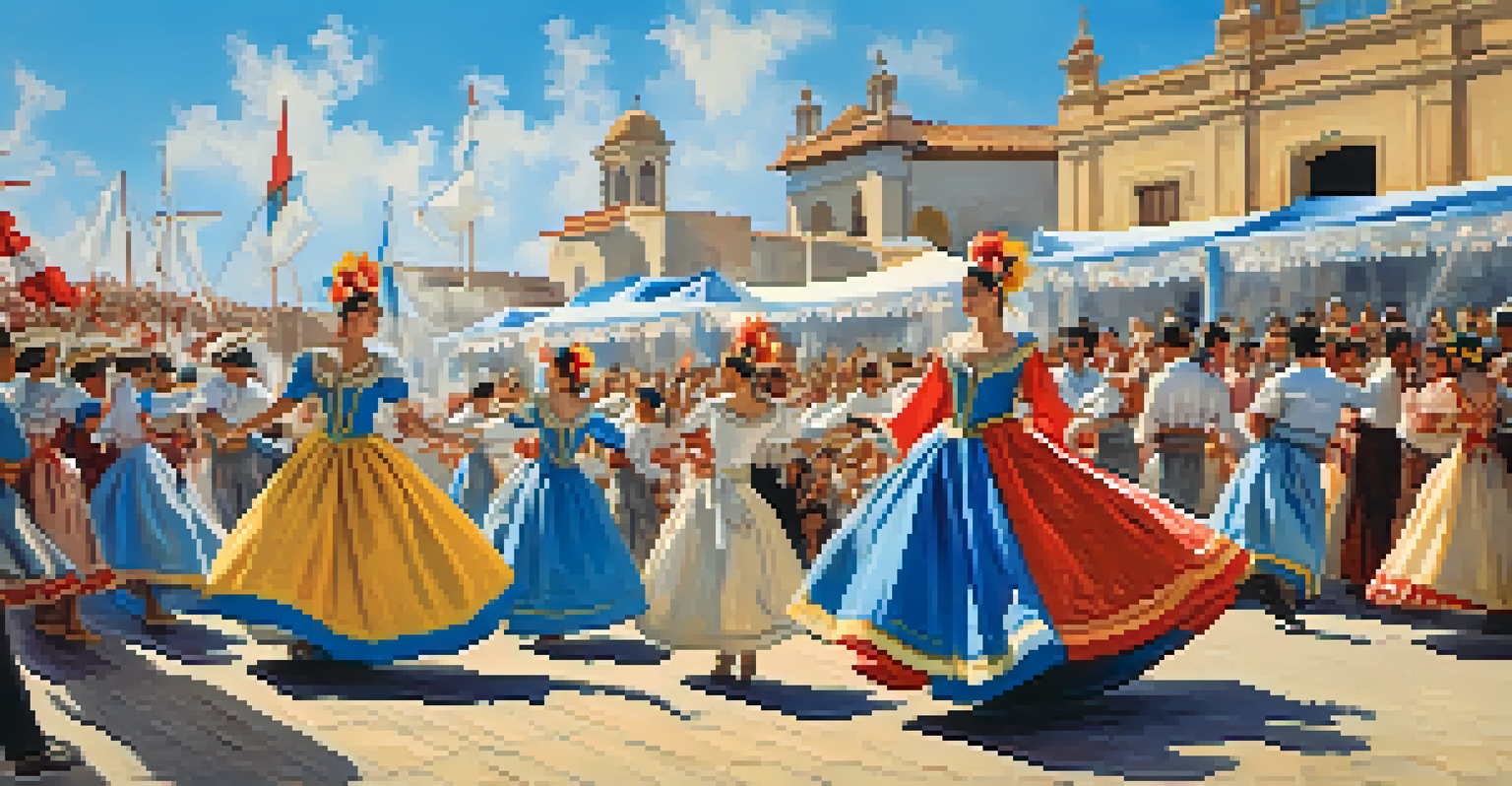Exploring Peru's Coastal Festivals: Celebrating Sea and Land

The Rich Tapestry of Coastal Festivals in Peru
Peru's coastline is not just a stunning stretch of beach; it’s alive with vibrant festivals that celebrate the sea's bounty and the land's beauty. These events reflect the rich cultural heritage of the coastal communities, showcasing their traditions, music, and cuisine. From the bustling markets to colorful parades, each festival creates a unique experience that invites visitors to participate in the local culture.
Festivals are a reflection of the culture that creates them, showing us the vibrant colors of life and community.
One of the most notable aspects of these festivals is their deep-rooted connection to the ocean. Many communities hold celebrations to honor the sea, acknowledging its importance for fishing and sustenance. This connection is palpable in the rituals, dances, and offerings made to the ocean, which highlight the respect and gratitude that locals have for the natural world.
In addition to celebrating the sea, many festivals also pay homage to the agricultural richness of the land. The interplay between land and sea is evident in the culinary delights served at these events, often featuring fresh seafood alongside locally-grown produce. This blend of flavors mirrors the spirit of collaboration between the coastal communities and the environment they cherish.
Fiesta de la Candelaria: A Cultural Extravaganza
One of Peru's most famous coastal festivals is the Fiesta de la Candelaria, held in Puno but celebrated by many coastal towns. This festival combines religious reverence with lively celebrations, where locals dress in vibrant traditional costumes and participate in elaborate parades. The atmosphere is electric, filled with music, dancing, and the scent of delicious food wafting through the air.

The festival honors the Virgin of Candelaria, who is believed to protect the community’s fishermen and their families. Rituals include offerings to the Virgin, showcasing the deep spiritual connection that coastal residents have with their patron saint. This blend of faith and festivity creates a unique experience that resonates with both locals and visitors alike.
Celebrating Coastal Traditions
Peru's coastal festivals blend vibrant cultural heritage with deep respect for the sea and land.
Beyond the religious aspects, the Fiesta de la Candelaria also serves as a platform for cultural exchange. Visitors can immerse themselves in workshops, learn traditional dances, and taste local delicacies. This festival not only celebrates the sea and land but also fosters a sense of community and shared heritage.
Festival de la Marinera: Dance of the Sea
The Festival de la Marinera, celebrated in the coastal city of Trujillo, is a vibrant tribute to the art of dance and the sea. This festival showcases the Marinera, a traditional Peruvian dance that reflects the courtship between a sailor and a lady. The graceful movements and colorful costumes make it a visual feast, drawing spectators from all over the country.
Food is not just what we eat; it’s a language, a celebration, and a way to connect with our heritage.
During the festival, local dancers compete in various categories, demonstrating their skills and passion for this beloved dance. The atmosphere is filled with excitement as families and friends gather to cheer on their favorites. This event not only highlights the importance of the Marinera but also strengthens community ties through shared cultural expressions.
Beyond the dance, the festival is also a celebration of Trujillo's rich culinary heritage. Food stalls line the streets, offering mouthwatering dishes that represent the region's coastal flavors. This combination of dance and gastronomy embodies the spirit of the festival, making it a must-see for anyone exploring Peru’s coastal celebrations.
Semana Santa: A Coastal Spiritual Journey
Semana Santa, or Holy Week, is celebrated with great fervor along Peru’s coast, particularly in cities like Lima and Arequipa. This week-long celebration is filled with religious processions, reenactments, and rituals that draw both locals and tourists into the spiritual atmosphere. The blend of faith and tradition makes this festival a profound experience for participants.
The coastal regions showcase unique interpretations of the Semana Santa rituals, with stunning floral arrangements and intricate altars that reflect local artistry. The processions often take place by the sea, symbolizing the connection between faith and the natural world. The sound of drums and the sight of colorful floats create a captivating scene that leaves a lasting impression.
Community and Cultural Exchange
Festivals like the Fiesta de la Candelaria and Festival de la Marinera foster a sense of community and cultural sharing among locals and visitors.
As the week progresses, communities come together to share meals and stories, reinforcing bonds and traditions. This communal aspect of Semana Santa transforms it from a religious observance into a celebration of life, love, and the shared values that unite the coastal communities. It’s an invitation to witness the depth of Peruvian culture through the lens of spirituality.
El Señor de los Milagros: A Coastal Devotion
El Señor de los Milagros, or the Lord of Miracles, is another significant coastal festival that showcases the intertwining of faith and cultural identity in Peru. Celebrated predominantly in Lima, this event attracts thousands who come to honor the miraculous image of Christ. The festival is characterized by grand processions, where the image is carried through the streets amid vibrant music and prayer.
This celebration holds deep meaning for many locals, as it represents hope and resilience in the face of adversity. The devotion to El Señor de los Milagros transcends religious boundaries, uniting people from diverse backgrounds in a shared expression of faith. The atmosphere is imbued with a sense of reverence and community that enhances the overall experience.
As participants walk alongside the procession, they often dress in traditional purple attire, symbolizing their devotion. This collective participation fosters a sense of belonging and pride among the community members. The festival not only honors the divine but also celebrates the rich tapestry of Peruvian culture that thrives along the coast.
Chiclayo's Festival de la Tumbes: A Celebration of Culture
Chiclayo, known for its archaeological treasures, also hosts the Festival de la Tumbes, which celebrates the region's cultural diversity. This festival is a vibrant showcase of music, dance, and art, highlighting the unique traditions of the coastal communities. It’s a time when locals come together to celebrate their heritage and share it with visitors.
During the festival, attendees can enjoy traditional dances like the Norteño and the Festejo, which reflect the joyful spirit of the coast. Food stalls offer a variety of regional dishes, allowing visitors to taste the flavors that define Peruvian coastal cuisine. This culinary aspect adds another layer of richness to the cultural experience, making it a feast for the senses.
Future of Festivals and Sustainability
As festivals evolve, there is a growing emphasis on sustainability and inclusivity to preserve cultural traditions and protect the environment.
The festival also features art exhibitions and workshops, providing opportunities for local artists to showcase their talents. This emphasis on creativity fosters a sense of pride and unity within the community, reinforcing the importance of preserving cultural traditions. The Festival de la Tumbes not only celebrates the past but also looks towards a vibrant future.
Culinary Festivals Along the Coast: Flavors of the Sea
Culinary festivals are a delicious highlight of Peru’s coastal celebrations, showcasing the incredible seafood that the region has to offer. Events like the Festival de la Gastronomía Peruana in Lima feature chefs and food enthusiasts coming together to celebrate local flavors. The focus is on fresh, sustainable seafood that reflects the rich marine biodiversity of the Pacific Ocean.
During these festivals, visitors can sample a variety of dishes, from ceviche to tiraditos, each telling a story of the sea. Cooking demonstrations and tastings allow attendees to engage with local chefs and learn about the techniques that make Peruvian cuisine so unique. This interactive experience not only enhances appreciation for the food but also fosters a sense of community among participants.

These culinary festivals often highlight the importance of sustainability and responsible fishing practices. As communities come together to celebrate their culinary heritage, there’s also a growing awareness of the need to protect the ocean's resources. This blend of celebration and education ensures that the flavors of the coast can be enjoyed for generations to come.
The Future of Coastal Festivals in Peru
As the world continues to change, Peru's coastal festivals are also evolving, embracing modern influences while maintaining their traditional roots. Many festivals are becoming more inclusive, inviting diverse communities to participate and celebrate together. This evolution is a testament to the resilience and adaptability of Peruvian culture.
Sustainability is becoming a central theme in these celebrations, with organizers focusing on eco-friendly practices to protect the coastal environment. Initiatives like waste reduction and promoting local artisans are helping to preserve the cultural integrity of these festivals while also safeguarding the natural beauty of the coast. It’s a promising step towards a more sustainable future.
Ultimately, the future of Peru's coastal festivals lies in the hands of the younger generations. As they take on leadership roles, there’s an opportunity to blend tradition with innovation, ensuring that these vibrant celebrations continue to thrive. By nurturing a love for their culture and environment, Peru's coastal communities are ensuring that the magic of their festivals endures for years to come.